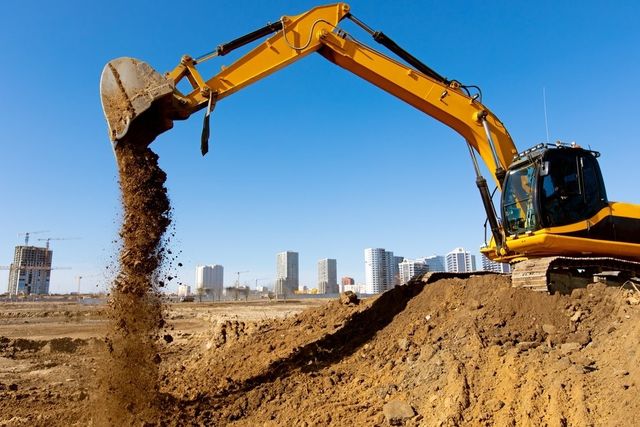Budget-friendly Lancaster Excavation - High Quality Excavation at Competitive Prices
Budget-friendly Lancaster Excavation - High Quality Excavation at Competitive Prices
Blog Article
Extensive Expedition: The Scientific Research Behind Superior Excavation Practices
The realm of excavation practices is a domain name where science links with craftsmanship to discover the enigmas concealed underneath the planet's surface. From old hand devices to modern-day hydraulic excavators, the advancement of excavation methods has actually been a testimony to human resourcefulness and technical improvements. However, what really establishes exceptional excavation techniques apart is a deep understanding of geological principles, coupled with the usage of innovative tools and techniques. By checking out the scientific research behind these methods, we can uncover the keys that exist underneath our feet and value the accuracy and know-how that go right into every dig.
Evolution of Excavation Methods
Throughout background, the advancement of excavation techniques has played an important function in progressing building techniques and archaeological discoveries. From the fundamental devices utilized by our forefathers to the advanced machinery employed in modern-day times, the development of excavation techniques has actually dramatically changed just how we approach various projects.
In ancient times, hand-operated labor with standard tools such as shovels, wheelbarrows, and pickaxes was the key approach of excavation. This labor-intensive process restricted the deepness and extent of excavations, typically causing slow-moving development and restricted accessibility to particular sites. As people progressed, so did the techniques and tools used for excavation.
The Industrial Change noted a transforming point in excavation practices with the introduction of steam-powered equipment. In contemporary times, technology plays an essential function in excavation, with improvements like GPS systems, drones, and 3D scanning enhancing accuracy and performance in the area.
Role of Innovation in Excavation

The assimilation of innovative modern technology has actually essentially reinvented the area of excavation, improving precision and effectiveness to unmatched degrees. One of the key technological developments that has substantially influenced excavation methods is the usage of GPS systems. These systems enable accurate mapping of excavation websites, making it possible for drivers to accurately locate below ground utilities and frameworks. Furthermore, using telematics in excavation tools has allowed real-time surveillance of device efficiency, causing proactive maintenance and increased functional efficiency.
Additionally, the arrival of 3D modeling and simulation software has structured the planning procedure for excavation tasks. Drivers and engineers can currently picture the entire excavation process prior to beginning, recognizing potential difficulties and enhancing workflow. Combined with this, the application of drones in excavation activities has actually promoted airborne studies, volumetric measurements, and website inspections with unrivaled speed and precision.
Geological Concepts in Excavation
An understanding of geological principles is essential for making sure the structural integrity and security of excavation websites. Geological aspects play a vital function in identifying the usefulness and safety and security of excavation tasks.
Furthermore, the geological structure of the location, including faults, fractures, and rock formations, must be carefully analyzed to identify potential risks and challenges. Digging deep into near fault lines or unstable rock formations can cause instability and possible risks. By carrying out detailed geological studies and evaluation, excavators and designers can develop approaches to alleviate threats and ensure the successful completion of excavation tasks. Ultimately, integrating geological principles into excavation techniques is vital for achieving risk-free, reliable, and lasting results.

Most Current Tools for Excavation
In the world of excavation methods, modern innovations in devices have actually transformed the performance and precision of excavation processes. One of the most current tools making waves in the market is the use of drones outfitted with advanced imaging technology. These drones can provide comprehensive aerial surveys of excavation sites, offering real-time information on topography and potential hazards. visit their website This information help in far better preparation and decision-making throughout the excavation procedure.
Another cutting-edge tool getting appeal is the execution of 3D printing technology for developing custom excavation equipment. This enables the manufacturing of specialized tools that are customized to the specific needs of a task, enhancing performance and minimizing downtime.
In addition, advancements in materials scientific research have actually caused the growth of more powerful and much more resilient excavation tools. excavating ohio. Tungsten carbide-tipped excavator add-ons, for example, deal premium performance in tough ground conditions, boosting efficiency on-site
Scientific research's Effect on Excavation Practices

Furthermore, advancements in products scientific research have caused the production of more powerful, a lot more long lasting excavation tools and devices. The use of composite materials in shovels and diggers has actually boosted their efficiency and durability, eventually increasing productivity on excavation sites. In addition, clinical research study on dirt visit this website auto mechanics and geotechnical engineering has actually offered beneficial understandings into soil behavior, allowing excavation experts to make informed choices regarding excavation methods and soil stabilization methods. On the whole, science proceeds to drive technology and enhancement in excavation practices, making excavation tasks a lot more effective, cost-efficient, and lasting.

Final Thought
Finally, the development of excavation techniques has actually been greatly affected by improvements in technology and a much deeper understanding of geological concepts. The most recent devices and equipment used in excavation have actually boosted efficiency and precision in the this content field. The application of scientific understanding has substantially boosted excavation methods, bring about much more lasting and efficient approaches for excavating different kinds of products.
In the world of excavation methods, modern developments in tools have actually reinvented the performance and accuracy of excavation processes. By leveraging scientific principles, the excavation industry has actually been able to considerably enhance effectiveness, precision, and safety in excavation procedures. GPR allows excavation teams to non-invasively check and map subsurface structures, utilities, and prospective dangers, allowing them to prepare excavation projects with greater accuracy and minimized risk of accidents.
Additionally, scientific research on dirt technicians and geotechnical engineering has provided useful insights right into soil habits, enabling excavation specialists to make educated decisions concerning excavation techniques and soil stabilization strategies. In general, science proceeds to drive technology and improvement in excavation methods, making excavation projects more reliable, cost-efficient, and sustainable.
Report this page